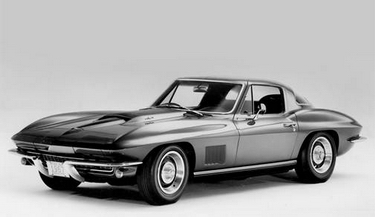Vette News - Corvette: Milestones & More - C2
Over its 60-odd-year run, the Corvette has largely stuck to its original objective of providing homegrown performance wrapped in a stylish, two-seat package. Its journey has at times been an uncertain one, but now in its seventh generation, it's safe to say the hits have outnumber the misses. Here's our look at the Corvette story from conception to the C7. This is article two in a series of seven.

C-2: 1963 - 1967
1963-1964: Restyled along lines laid down by design boss Bill Mitchell's 1959 race car and re-engineered
to be the first Corvette that Duntov wouldn't be ashamed to drive in Europe, the Sting Ray arrives for '63 with
hidden headlamps the famed "split-window" fastback that lasts for only one model year. It is smaller, has an
independent rear suspension with a single transverse leaf spring, and offers electronic ignition. The Z06 Special
Performance Equipment option is introduced on the 1963 Sting Ray (199 built), and the Corvette Grand Sport program
builds five lightweight, race-ready cars, all sold to racing privateers.
1965: The big block V-8 arrives in the form of Chevy's 396-cubic-inch "L78" engine. Four-wheel disc brakes
become standard, and fuel injection disappears until 1982's throttle-body injection.
1966: The big block grows to 427 cubes. Originally listed at 450 horsepower in Chevy literature, numbers for
the solid lifter beast were revised to 425 after introduction. This is solely an administrative decision, and no changes
to the engine were made. Backup lamps and Holley carbs (previously available only on certain models) were made standard.
1967: The C2's swan song, the 1967 model introduces the legendary L88 cast-iron big-block engine. GM rates it at
430 hp, but it routinely tops 500 hp in independent testing. Aluminum cylinder heads became an option for the L71 engine,
and a dual-master-cylinder braking system becomes standard.
Credits: Internet article/series by Andrew Wendler and Kevin Wilson